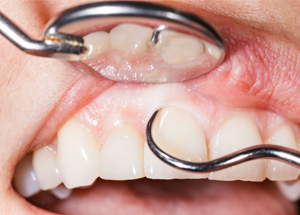WHAT IS GUM (OR PERIODONTAL) DISEASE?
Gum Disease affects 2 out of 4 Americans, according to the CDC. Given these stats, it’s crucial to know if you have it and what to do about it. Think of your gums as the foundations of your teeth. If the teeth are the walls, your gums are what support those walls. If the terrain where your house is built is not very stable, your walls may become wobbly, and you will most likely have some structural issues that not only will take time to fix, but also a LOT of money. Gums work the same way: you may have the strongest teeth, but if they are not well supported, they will fracture or fall, regardless of how white, healthy or strong your teeth might be.
So basically your teeth are as good as your gums are. If your gums are disease-free (aka pink and blood-free), your teeth will have a solid foundation to rest on. So how do you get there? It’s a simple regiment, but it requires discipline and dedication:
- Regular professional cleanings (preferably 2-3 times a year, depending on your age and the state of your gums),
- Good home care habits (brushing and flossing on a daily basis),
- Regular dental check-ups.
If you do this, chances are that you will keep your gums healthy, and avoid expensive treatments and regular visits to your dentist’s office.
HOW DO I KNOW IF I HAVE IT?

If you are reading this article, chances are that you already have been diagnosed with some form of gum or periodontal disease. Or perhaps someone you know has told you about it. Maybe your gums bleed every time you floss, or you suffer from consistent bad breadth. Or recently you noticed your gums look pale or irritated, so you are starting to get concerned.
It is unfortunate, but it is a fact that periodontal disease affects as much as 1 out of 2 Americans. Gum disease comes in different levels of seriousness, from a curable (and totally preventable) gingivitis to advanced periodontal disease which, if left untreated, can lead to bone loss (aka, your teeth start to wobble). If you don’t know if you have gum disease or you are not sure which type you have, it is best to see a dentist. He or she will tell you right away. And just like every disease out there, if you are able to catch it early, it will mean less time in the chair, and much less money out of your pocket.
Check out the next post, “Types of Periodontal Disease”, where we will tell you about the different types of gum or periodontal disease and how to treat them correctly.
If you want to learn more about gum disease or want to know if you actually have it, feel free to email or call us at
Email: info@drsrohrer.com
Phone: (561) 404-7360